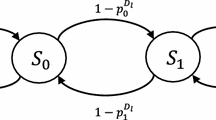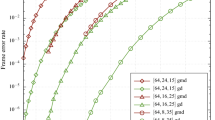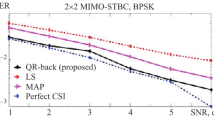Abstract
Joint source-channel decoding is considered for a transmission system, in which the quantizer indices of several autocorrelated source signals are bit-interleaved, commonly channel encoded, and transmitted in parallel. Since the optimal decoding algorithm is not feasible in most practical situations, iterative source-channel decoding has been introduced. The latter is generalized in the present paper. Furthermore, it is shown in detail, that iterative source-channel decoding can be derived by insertion of appropriate approximations into the optimal joint decoding algorithm. The approximations allow the decomposition of the optimal decoder into two parts, which can be identified as the constituent decoders for the channel-code and the source-code redundancies. Similar as in other concatenated coding systems, the constituent decoders are applied in an iterative decoding scheme. Its performance is analyzed by simulation results.
Résumé
Dans cet article, nous considérons le décodage conjoint source-canal pour un système de transmission, dans lequel les indices des quantificateurs de plusieurs sources auto-corrélées sont entrelacés bit par bit, codés ensemble par un codage de canal, et transmis en parallèle. Comme l’algorithme de décodage optimal est trop complexe, le décodage iteratif source-canal est introduit et généralisé dans cet article. De plus, nous démontrons en détail que le décodage source-canal itératif peut se déduire après quelques approximations de l’algorithme de décodage conjoint optimal. Ces approximations per mettent la décomposition du décodeur optimal en deux parties que l’on peut identifier comme les décodeurs constituants prenant en compte respectivement la redondance du codage de canal et la redondance résiduelle du codage de source. Comme dans d’autres systèmes concaténés de codage, les décodeurs constituants sont utilisés dans un processus de décodage itératif. Les performances sont analysées grâce aux résultats de simulation.
Similar content being viewed by others
References
Farvardin (N.), “A study of vector quantization for noisy channels”,ieee Transactions on Information Theory, vol. 36, n° 4, pp. 799–809, July 1990.
Miller (D.), Rose (K.), “Combined source-channel vector quantization using deterministic annealing”,ieee Transactions on Communications, vol. 42, n° 2/3/4, pp. 347–356, Feb./Mar./Apr. 1994.
Zeger (K.), Gersho (A.), “Pseudo-Gray coding”,ieee Transactions on Communications, vol. 38, n° 12, pp. 2147–2158, Dec. 1990.
Hagenauer (J.), “Source controlled channel decoding”,ieee Transactions on Communications, vol. 43, n° 9, pp. 2449–2457, Sept. 1995.
Hindelang (T.), Ruscitto (A.), “Kanaldecodierung mit Apriori-Wissen bei nicht binären Quellensymbolen,” inProceedings of the ITG-Fachtagung “Codierung für Quelle, Kanal und Übertragung”, Mar. 1998, pp. 163–167.
Heinen (S.), Geiler (A.), Vary (P.), “MAP channel decoding by exploiting multilevel source a priori knowledge,” inProceedings of the ITG-Fachtagung “Codierung für Quelle, Kanal und Übertragung”, Mar. 1998, pp. 89–94.
Sayood (K.), Borkenhagen (J.C.), “Use of residual redundancy in the design of joint source/channel coders”,ieee Transactions on Communications, vol. 39, n° 6, pp. 838–846, June 1991.
Phamdo (N.), Farvardin (N.), “Optimal detection of discrete Markov sources over discrete memoryless channels - applications to combined source-channel coding,”IEEE Transactions on Information Theory, vol. 40, n° 1, pp. 186–193, Jan. 1994.
Fingscheidt (T.), Vary (P.), “Robust speech decoding: A universal approach to bit error concealment,” inProceedings of the ieee International Conference on Acoustics, Speech, and Signal Processing (icassp), Apr. 1997, vol. 3, pp. 1667–1670.
Skoglund (M.), “Hadamard-based soft decoding for vector quantization over noisy channels,”ieee Transactions on Information Theory, vol. 45, n° 2, pp. 515–532, Mar. 1999.
Bahl (L.R.), Cocke (J.), Jelinek (R), Raviv (J.), “Optimal decoding of linear codes for minimizing symbol error rate,”ieee Transactions on Information Theory, vol. IT-20, pp. 284–287, Mar. 1974.
Hagenauer (J.), Hoeher (P.), “A Viterbi algorithm with soft-decision outputs and its applications,” inProceedings of the Global Telecommunications Conference (globecom), Nov. 1989, vol. 3, pp. 1680–1686.
Görtz (N.), “Joint source-channel decoding using bit-reliability information and source statistics,” inIEEE Proceedings of the International Symposium on Information Theory (isit), Aug. 1998, p. 9.
Görtz (N.), “Joint source-channel decoding by channel-coded. optimal estimation,” inProceedings of the 3rd ITG Conference Source and Channel Coding, Jan. 2000, pp. 267–272.
Heinen (S.), Bleck (S.), Vary (P.), “Robust speech transmission over noisy channels employing nonlinear block codes,” inProceedings of theieee Speech Coding Workshop, June 1999, pp. 72–74.
Görtz (N.), “Iterative source-channel decoding using soft-in/soft-out decoders,” inProceedings of the ieee International Symposium on Information Theory (isit), June 2000, p. 173.
Görtz (N.), “Analysis and performance of iterative source-chan- nel decoding,” inProceedings of the International Symposium on Turbo Codes and Related Topics, Sept. 2000, pp. 251–254.
Görtz (N.), “On the iterative approximation of optimal joint source-channel decoding,”ieee Journal on Selected Areas in Communications, accepted for publication.
HlNDELANG (T.), FlNGSCHEIDT (T.), SESHADRI (N.), COX (R.V.), “Combined source/channel (de-)coding: Can a priori information be used twice?,” inProceedings of the IEEE International Symposium on Information Theory (kit), June 2000, p. 266.
Görtz (N.), “Zero-redundancy error protection for celp speech codecs,” inProceedings of the European Conference on Speech Communication and Technology (eurospeech), Sept. 1997, vol. 3, pp. 1283–1286.
Schroeder (M.R.), Atal (B.S.), “Code-excited linear prediction (celp): high-quality speech at very low bit rates,” inProceedings of the IEEE International Conference on Acoustics, Speech, and Signal Processing fiCASSPJ, Mar. 1985, vol. 1, pp. 25.1.1–25.1.4.
Hagenauer (J.), Offer (E.), Papke (L.), “Iterative decoding of binary block and convolutional codes,”IEEE Transactions on Information Theory, vol. 42, n° 2, pp. 429–445, Mar. 1996.
Berrou (C), Glavieux (A.), “Near optimum error correcting coding and decoding: Turbo-codes,”IEEE Transactions on Com- munications, vol. 44, n° 10, pp. 1261–1271, Oct. 1996.
Robertson (P.), Hoeher (P.), Villebrun (E.), “Optimal and sub-optimal maximum a posteriori algorithms suitable for turbo decoding,”European Transactions on Telecommunications (ETT), vol. 8, n° 2, pp. 119–125, Mar. 1997.
Jayant (N.S.), Noll (P.), Digital Coding of Waveforms,Prentice-Hall, Inc., Englewood Cliffs, New Jersey, 1984.
Author information
Authors and Affiliations
Corresponding author
Rights and permissions
About this article
Cite this article
GöRTZ, N. A generalized framework for iterative source-channel decoding. Ann. Télécommun. 56, 435–446 (2001). https://doi.org/10.1007/BF02995454
Received:
Accepted:
Issue Date:
DOI: https://doi.org/10.1007/BF02995454




